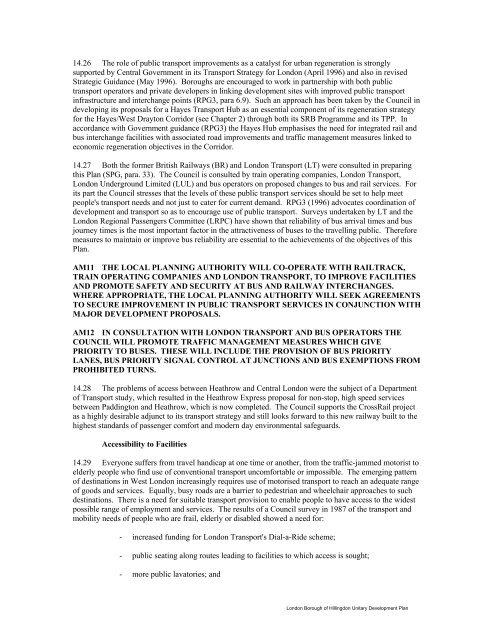HILLINGDON UNITARY DEVELOPMENT PLAN - London Borough ...
HILLINGDON UNITARY DEVELOPMENT PLAN - London Borough ...
HILLINGDON UNITARY DEVELOPMENT PLAN - London Borough ...
Create successful ePaper yourself
Turn your PDF publications into a flip-book with our unique Google optimized e-Paper software.
14.26 The role of public transport improvements as a catalyst for urban regeneration is strongly<br />
supported by Central Government in its Transport Strategy for <strong>London</strong> (April 1996) and also in revised<br />
Strategic Guidance (May 1996). <strong>Borough</strong>s are encouraged to work in partnership with both public<br />
transport operators and private developers in linking development sites with improved public transport<br />
infrastructure and interchange points (RPG3, para 6.9). Such an approach has been taken by the Council in<br />
developing its proposals for a Hayes Transport Hub as an essential component of its regeneration strategy<br />
for the Hayes/West Drayton Corridor (see Chapter 2) through both its SRB Programme and its TPP. In<br />
accordance with Government guidance (RPG3) the Hayes Hub emphasises the need for integrated rail and<br />
bus interchange facilities with associated road improvements and traffic management measures linked to<br />
economic regeneration objectives in the Corridor.<br />
14.27 Both the former British Railways (BR) and <strong>London</strong> Transport (LT) were consulted in preparing<br />
this Plan (SPG, para. 33). The Council is consulted by train operating companies, <strong>London</strong> Transport,<br />
<strong>London</strong> Underground Limited (LUL) and bus operators on proposed changes to bus and rail services. For<br />
its part the Council stresses that the levels of these public transport services should be set to help meet<br />
people's transport needs and not just to cater for current demand. RPG3 (1996) advocates coordination of<br />
development and transport so as to encourage use of public transport. Surveys undertaken by LT and the<br />
<strong>London</strong> Regional Passengers Committee (LRPC) have shown that reliability of bus arrival times and bus<br />
journey times is the most important factor in the attractiveness of buses to the travelling public. Therefore<br />
measures to maintain or improve bus reliability are essential to the achievements of the objectives of this<br />
Plan.<br />
AM11 THE LOCAL <strong>PLAN</strong>NING AUTHORITY WILL CO-OPERATE WITH RAILTRACK,<br />
TRAIN OPERATING COMPANIES AND LONDON TRANSPORT, TO IMPROVE FACILITIES<br />
AND PROMOTE SAFETY AND SECURITY AT BUS AND RAILWAY INTERCHANGES.<br />
WHERE APPROPRIATE, THE LOCAL <strong>PLAN</strong>NING AUTHORITY WILL SEEK AGREEMENTS<br />
TO SECURE IMPROVEMENT IN PUBLIC TRANSPORT SERVICES IN CONJUNCTION WITH<br />
MAJOR <strong>DEVELOPMENT</strong> PROPOSALS.<br />
AM12 IN CONSULTATION WITH LONDON TRANSPORT AND BUS OPERATORS THE<br />
COUNCIL WILL PROMOTE TRAFFIC MANAGEMENT MEASURES WHICH GIVE<br />
PRIORITY TO BUSES. THESE WILL INCLUDE THE PROVISION OF BUS PRIORITY<br />
LANES, BUS PRIORITY SIGNAL CONTROL AT JUNCTIONS AND BUS EXEMPTIONS FROM<br />
PROHIBITED TURNS.<br />
14.28 The problems of access between Heathrow and Central <strong>London</strong> were the subject of a Department<br />
of Transport study, which resulted in the Heathrow Express proposal for non-stop, high speed services<br />
between Paddington and Heathrow, which is now completed. The Council supports the CrossRail project<br />
as a highly desirable adjunct to its transport strategy and still looks forward to this new railway built to the<br />
highest standards of passenger comfort and modern day environmental safeguards.<br />
Accessibility to Facilities<br />
14.29 Everyone suffers from travel handicap at one time or another, from the traffic-jammed motorist to<br />
elderly people who find use of conventional transport uncomfortable or impossible. The emerging pattern<br />
of destinations in West <strong>London</strong> increasingly requires use of motorised transport to reach an adequate range<br />
of goods and services. Equally, busy roads are a barrier to pedestrian and wheelchair approaches to such<br />
destinations. There is a need for suitable transport provision to enable people to have access to the widest<br />
possible range of employment and services. The results of a Council survey in 1987 of the transport and<br />
mobility needs of people who are frail, elderly or disabled showed a need for:<br />
- increased funding for <strong>London</strong> Transport's Dial-a-Ride scheme;<br />
- public seating along routes leading to facilities to which access is sought;<br />
- more public lavatories; and<br />
<strong>London</strong> <strong>Borough</strong> of Hillingdon Unitary Development Plan
















